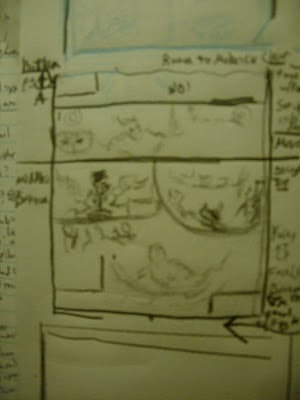Wednesday, September 28, 2011
Let's Draw: sequences
My goal is to create a story that introduces a concept. I want it in a form that can draw in the eye instantly. I want my reader to grasp the style and connect with the characters quickly. I want them to get through my sample in five minutes at the most.
I would like to continue telling stories about that concept, so I've thought about it until I had a good mixture of characters come forward, and a little space from my original, tragic inspiration. With them, I could see a way to tell future stories. That's what I think of as a storytelling engine.
So: first, I came up with an idea, and then, a plot, written on a couple of sheets of college rule notebook paper. My cast of characters grew from two to seven (not all of whom appear in the first story). I created a "handbook entry" which is to say I typed up some basic facts and back story.
Here's a little of the handbook entry for this story's featured character:
Real Name: Kumiko 'Kacey' Sakura (alternative pilot, Icharu Gorou Etsuko)
5'2" 43 kg Hair: Black Eyes: Brown
9'4" 256 kg Hair: none Eyes: Electric
Powers: Cybernetic interface with "Danger Bot," Jounzingen Kikensei, a nascent A.I. inside a nine foot tall robot
Danger Bot usually operates with three technicians to oversee the danger site, DB's mechanical body, and Kacey's health, but can function strictly under the wearer's guidance as well.
Danger Bot enables vision on different wavelengths than normal and enhanced audio reception, with Internet access and hacking capabilities.
There's more, but you get the basic idea: what can they do, what's the story that got them here. It's worth taking the time to put it together to your satisfaction.
Then, I typed up basic bits of dialogue, interspersed with notes where I wasn't sure exactly what was said---just the general idea. I will go back to my research to get a few details straight, but so that I don't over-do that stage, I am going to pace the story---with drawings.
It's a story about an idea that could become good and plausible in the real world in a few years, so it's idealistic, but hopefully, it will inspire practical applications. An under-funded foundation puts together a most unique rescue apparatus: a robot, with a pilot and technical support, made to brave the greatest of dangers.
My script's rough draft may have things like:
Page four
The roof! Catch it!
I’ve got it…but I’ll be trapped!
I think Gorou’s right, though; if that doorway’s blocked, it may take hours or an entire day to breach the control center.
Stay put, Sakura. The
I’ve got to come out.
What? No! You fool, you’ve entered a room with radiation levels of …
Nothing else to do about that.
Kacey…it’s deadly in there.
That way, I got through it quickly. When I present the script itself to others, it will be formatted with names of characters and descriptions of action. This is simply a guide to drawing what I see!
So, I started drawing versions of the pages, working out how they would look, what we might see, setting the stage. Along the way, I considered different facets of the details that will carry over into future episodes. I decided to pace this out over seven pages. it could easily be more, and include more of the back story or larger drawings, but I want it to appear brief, yet substantial. It tells a complete story.
I drew versions of the pages, side by side. I intended to draw them each as a whole page in my sketch book, but I chose to make that the step between this one---some artists call these "thumbnails" and they are representations of how the complete drawings will lay out on the page. I re-drew the first three as I went along, then squeezed in the absolutely essential action in my next two samples.
Then I decided what I could add to increase the suspense without slowing the story or over crowding the art. The material in those first two versions of page four and five were supplemented. Now they are pages four, five, and six.
I created one version of page six that wraps up the episode, with a seventh page then dedicated to an epilogue meant to spin off the next episode.
hsh
So, these scribbles will become stronger scribbles, and more attention to detail will develop as the idea takes visual form through revision.
Looking at it the next day, I see I could use parts of both to create a last page that moves more breathlessly towards the next bit of excitement. This establishes a pace where my reader envisions a story that barely lets you catch your breath!
Something to keep in mind: to get in the mood to draw for hours, I began by drawing something I was moved to draw, that I meant for someone else to enjoy, which also reminded me of my goal to create portraits of artists, famous and otherwise. Here's France's legendary singer Edith Piaf. The point is, I drew what I loved. Then, what I had planned all this time to draw came out of me remembering I love to draw!
Sequences are made of scenes. Scenes are made of clearly drawn people, animals, and things.
new/page/one/roughs
photo/ref/power/plant
All content created by Cecil Disharoon, copyright 2011 Integr8d Soul Productions
Subscribe to:
Post Comments (Atom)






















No comments:
Post a Comment